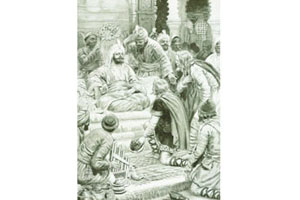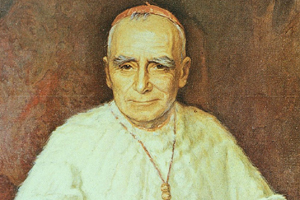Caliph Yazid I crushed the rebellion of Husayn, son of Ali (the fourth Caliph) in 680 A.D., who became a Shiite martyr.
After the caliphate of Walid I (705 – 715), the conflict worsened, provoking a decline in this dynasty’s power. The Khorasan Rebels and Iraq defeated Caliph Marwan II in August, 750 A.D. The new Caliph was Abu al Abas.
The Abbasids
The new dynasty moved the centre of the empire from Damascus to Baghdad, the present capital of Iraq.
Supported by the Persians, they devoted themselves to restoring the Islamic tradition they thought the Umayyads had betrayed.
They reinforced the Caliph’s theocratic power. The monarch’s divine right was strengthened and this consolidated Islam as a political system.
The new Caliphate dedicated itself to defending the faith more strongly, but was less questioned because there was not a recognised religious hierarchy.
Their greatest splendour occured during the reign of Harun al-Rashid (786-809). During his reign Baghdad was converted into a centre of art and culture.
After the death of Harun al-Rashid in 809, the succession to the throne provoked the division of the empire into relatively autonomous principalities and the struggle between two of his sons, Al-Mamun, who had a Persian mother, and the Caliph al-Amin, of Arab lineage. The latter was finally defeated and assassinated.
Under the reign of Al-Mamun the Arabs weakened and Persian culture and influence took hold of Baghdad.
On the other hand, the number of Turkish mercenary soldiers recruited from Central Asia increased. These soldiers became highly important, surpassing the Arabs to the point of modifying the political power of Islam. The Turkish mercenaries of the Caliph’s Guard and their chief, the Emir of Emirs, took control of the palace and contributed to the establishment of a separation between earthly and spiritual power.
Besides this, there were social tensions caused by unequal economic development. The lower classes, crushed by their misery, joined the extremists of Shiite sects which provoked various rebellions at the end of the 9th Century and the beginning of the tenth.
Division and the End
The devastation of Syria and Iraq by gangs named Qarmatians and insurrections of craftspeople and peasants resulted in the creation of the state of Bahrain, an archipelago in the Persian Gulf. Their forces took over Basra and Kufa, now in Iraq, and in 930 sacked Mecca.
In the 10th Century independent principalities were created which gradually divided the Abbasid Empire. The Andalusian Emirate in the Iberian Peninsula, founded in 756, was converted into the Umayyad Caliphate of Cordoba in 929. The descendents of Ali and Fatima (the daughter of Muhammad) were put in power in Egypt. The Kingdoms of Maghreb in Northern Africa became almost autonomous and in the east a number of Iranian states arose in Khurasan, north of the current Iran. An independent state also took shape in Syria.
The Abbasids held Baghdad until 945, when they were defeated by Ahmad al-Buyi, a Shiite adventurer from the Iranian mountains. His successor was able to seize a region comprised of two thirds of Iran and Mespotamia.
Halfway through the 11th Century, the Seljuk Turks, originally inhabiting the western borders of China and converted to Islamic orthodoxy by the Sunnis, conquered India and Iran.
Later, Tugril Beg’s forces headed towards Asia Minor to attack the Byzantine Empire and southwards to attack Baghdad, which was occupied in 1055. This led to the disappearance of the Buyyid Dynasty.
The Seljuk sultans conquered Asia Minor, Syria and Palestine. In the 12th Century, Baghdad, Aleppo and Damascus were conquered by the Mongols.
Al-Andalus
The territory of the Iberian Peninsula which was ruled by Muslims between 711 and 1492 was known as al-Andalus.
When the last Umayyad caliph, Marwan II, was overthrown in August 750, one member of this dynasty managed to escape. Abd ar-Rahman I established the Caliphate of Cordoba in al-Andalus in 756. During the government of Abd ar-Rahman II, Islam spread quickly, and the number of Mozarabs (Christians in Muslim territory) was considerably reduced.
Abd ar-Rahman III proclaimed himself Caliph in 929 to reverse political decline and end uprisings, declaring the religious independence of the Abbasid Caliphate. At the end of the 10th Century the power of the Caliphate extended northwards. Besides this there was also an important cultural development.
However in 1031, the Caliphate was abolished as a result of the fitna or civil war between supporters of the Umayyad Caliph, Hisham II, and the successors of his prime minister, or hajib, al-Mansur. A number of kingdoms arose known as the Taifas.
During the 11th and 12th Centuries, the Almoravids and Almohads who originated from Northern Africa, agreed to help these kingdoms which were gradually disappearing as a result of the advances of the Christian re-conquest after the expansion of the Kingdom of Aragon and the union of the kingdoms of Castilla and Leon took place. In the middle of the 13th Century, al-Andalus was reduced to the Nazari kingdom of Granada, founded by Muhammad ibn Nasar.
The last king of the Nazari dynasty was Boabdil, overthrown in 1492 by the Catholics Queen Isabella I of Castile and King Ferdinand II of Aragon.








